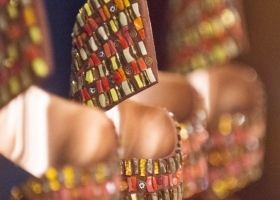
The Best ofIntima & Swim Edit
From Clicks to Bricks: Digital-Native Brands get physical
01 July 2019
From digital innovation and rising globalization to changes in consumer spending habits, there’s no doubt that the fashion industry and all of its segments are undergoing seismic shifts.

At the turn of the millenium, we watched as retailers rushed to put up websites – but could we have imagined that less than two decades later, the business model would reverse?
The past year has seen a record number of e-commerce retailers opening permanent stores, and the trend shows no signs of letting up: a remarkable 850 more are set to
open in the next five years. Digital-native retailers such as MeUndies, Adore Me and Fabletics are creating buzz by announcing expansion plans that demonstrate the value they place on having a physical store presence. Through its in-depth study of e-commerce brands opening brick-and-mortar stores across America, Retail Intelligence by JLL presents the key findings for this fascinating phenomenon, shared here alongside our case studies.
The expansion HUB
New York is the top city for digital-native brands’ brick-and-mortar expansion. More than half of clicks-to-bricks retailers opened their first pop-up locations in New York City (with most opting for SoHo as the prime urban corridor to test new concepts and woo customers), and more than a third opened their first permanent location there as well. Other popular cities to debut a pop-up and then subsequently a permanent store are Los Angeles (just behind New York), Detroit, Chicago, Washington, D.C. and San Francisco.

A GROWING LIST
OF PERMANENT STORE
2017 saw an explosion in clicks-to-bricks retailers, all opening permanent physical locations across North America. Half of them have high price points, like MM.Lafleur and Peloton, whereas 32% are mid- priced retailers like ModCloth and Chubbies.

Apparel & Accessories brands LEAD THE WAY
A grand total of 74.3% of clicks-to-bricks retailers are apparel and accessory brands like Warby Parker (eyewear) and Everlane (ethical RTW & underwear), and half of them have high price points, whereas 32% are midpriced retailers like Chubbies (men’s casual and swimshorts) and Quay Australia (sunglasses).
SHOWROOMS ARE STILL A NICHE
They came of age in the digital era, so it would make sense for clicks-to-bricks retailers to operate on a showroom model – to offer only samples of products for customers to try out and then ship actual purchases to shoppers’ homes from a warehouse. M.Gemi, the leather shoe retailer, and Universal Standard, the plus- sized apparel company, operate in a similar way to the showroom model. But despite the amount of attention that showrooms have garnered, only 15.1% of clicks-to-bricks physical stores don’t cary any inventory.

CASE STUDIES: EXPANDING RETAILER SNAPSHOTS

ADORE ME - After inaugurating its New York flagship store in Staten Island this past June, as we reported in the July 2018 edition of The Best of Intima, lingerie retailer Adore Me has announced up to 300 additional stores in the next five years. Given that the brand posted earnings of more than $100 million from online sales alone in 2017, the product offering has already proven itself. So what’s missing that could necessitate the move to physical stores? It’s all about the experience. To compete with the world’s leading luxury brands, Adore Me has integrated extra treats into its sales space: a marble “lingerie bar” stocked with candy and refreshments for clients, and “smart” fitting rooms that allow shoppers to request additional sizes by tapping on a sceen. Experiences like these – the personal touch that simply doesn’t translate online – foster a sales- boosting sense of indulgence, community and customer service.

MEUNDIES
Self-described as “the world’s most
comfortable underwear,” MeUndies launched
in 2011 as an e-commerce selling
undergarments. From the beginning, the
company was classified as disruptive,
representing a new breed of online-only retailers selling basics – a market that has attracted over $50
million in venture capital over the last five years – and offering the first-ever underwear subscription service. MeUndies resonated with customers for its fun and user-friendly website, alongside comfortable products that prioritize responsible manufacturing. But the brand was not content to stop at a world-class digital shopping experience. After being named on the Inc. 5000 list as the 7th Fastest Growing Retail Company in the US, MeUndies
began testing the waters of physical retail space in 2017 with a
series of pop-ups around California – first in Venice
Beach, and again in Silicon Valley. When both met with success, MeUndies opened its first retail store
in 2018 in a Los Angeles shopping center on the
iconic Santa Monica Boulevard.

CHUBBIES
Founded in 2011 as a website retailing retro- inspired casual and swim shorts for men, the Chubbies brand quickly gained traction despite facing intense competition from huge brick-and- mortar retailers in the shorts market like Gap, J. Crew and Abercrombie, who cater to the same 18-to-35-year-old male demographic. After polling its extensive customer community to find out where it should place its physical hubs, Chubbies opened its own brick-and-mortar sales space in San Francisco and now operates 11 stores throughout the major metropolitan areas
of the US, from Dallas to Atlanta to Washington, D.C.
As they expand, what CHALLENGES & OPPORTUNITIES do retailers face?
RETAIL GEOGRAPHY IS FRAGMENTED.
The top US markets make up only 33% of the nation’s retail space, and major retailers may find themselves opening hundreds of stores across many markets before their presence is truly felt nationally.

RETAIL IS LOW DENSITY.
While malls and high streets do play an important role, with malls across the US remaining much the same for decades, most retail is spread out across suburban shopping centers and freestanding buildings. This set-up places a premium on parking spaces, as trade areas are often defined by car accessibility. And as more Americans live in an urban setting, lifestyle centers are slowly becoming the new high street, featuring up-scale tenants that emphasize aspirational and luxury brands.
MULTIPLE MARKETS COMBINE FOR A BIG IMPACT.
New York’s GDP is roughly the same size as Spain. If it were a nation, it would be ranked #15. Likewise, the state of California by itself is the world’s eighth largest economy, about the same as that of Brazil.
THE US MARKET HAS VASTLY MORE SHOPPING OPTIONS THAN OTHER COUNTRIES.
The country boasts over six times more square feet of retail space per person than, for example, the UK. With no shortage of space, brands looking to make the leap from online to in-store should have no problem obtaining the square feet they need.
The changing US consumer typology
MILLENNIALS ARE MAKING A MAJOR IMPACT.
Generation Y, made up of about 80 million people, represents 25% of the US population, bringing with it a unique set of shopping habits and growing purchasing power. Today, millennials are responsible for approximately $600 billion in spending, but that figure is expected to grow to $1.4 trillion by 2020. It’s clear that retailers cannot afford to overlook this demographic moving forward.

CONSUMERS ARE MOVING TO MOBILE.
It comes as no surprise that the generation that came of age in the digital era would be attached to their mobile devices, causing mobile commerce to
gain traction as users spend more time online. This represents a significant opportunity for brick-and-mortar retailers who can successfully broaden their distribution channels, particularly in the Apparel & Accessories category, which makes up just over 16% of online sales.
Copyright 2024. All right reserved - Terms










